Abstract
By means of a newly designed portable aerosol mass spectrometer SPLAT (Single Particle Laser Ablation Time-of-flight mass spectrometer) for the analysis of single atmospheric aerosol particles we investigated the system performance in dependency on two different aerodynamic lenses (Liu and Schreiner type) capable of focusing particles with diameters ranging from 80 nm to 800 nm and 300 nm to 3000 nm, respectively. By using the pressure regulated Schreiner lens, the instrument is independent of variations in atmospheric pressure which would lead to changing dynamical properties of the aerosol particles. Active pressure control inside the inlet system facilitates airborne measurements without complicated corrections. With the Liu setup no pressure regulation was used. Here the overall efficiency of our instrument was 7% while with the Schreiner setup 2% was achieved. The Liu lens setup is optimal for measuring submicron particles at low particle concentrations. To detect supermicron particles the Schreiner lens setup is favored. Together with these experiments we present key details of the SPLAT setup and its characterization. Our instrument is able to measure simultaneously the size and the chemical composition of individual aerosol particles larger than 300 nm in diameter. It uses forward scattered light of single aerosol particles at two positions to determine their vacuum aerodynamic diameter from the flight time between the two lasers. Chemical analysis of the particles is done by laser ablation mass spectrometry utilizing a bipolar time-of-flight mass spectrometer.
INTRODUCTION
Online mass spectrometry for the chemical analysis of aerosols has become an important method in atmospheric research (CitationNash et al. 2006). One of the major issues connected with particle mass spectrometers is the design of suitable sampling inlets. Such inlets need to provide sufficient particle numbers for analysis inside the vacuum cell as well as permit entrance of the size range covered by the detection method. For mass spectrometric chemical particle analyses two main approaches are distinguished, each of which requires specific inlet designs: (1) thermal vaporization of aerosol ensembles with subsequent electron impact ionization (EI) and mass separation by time-of-flight (TOF) or a quadrupole mass spectrometry (CitationCanagaratna et al. 2007), described in the literature as Aerosol Mass Spectrometer (AMS) and (2) vaporization and ionization with a laser pulse and mass separation by a TOF-MS (CitationMurphy 2007).
The former technique generally analyzes aerosol ensembles and generates quantitative data but only of material which is vaporized at temperatures up to 600°C. With the latter technique single particles are analyzed (type I instruments are also capable of analyzing single particles). In practice the instruments of type I are designed for particles with sizes from a few tens of nanometers to roughly 1 micron while those of type II commonly detect particles from > 100 nm to a few microns. Already from this difference the need for specific inlet designs arises. Laser desorption/ionization (LDI) enables the detection of refractory material (on the expense of being quantitative) and therefore complements AMS measurements.
Besides a commercial instrument (ATOFMS, Aerosol Time-of-flight Mass Spectrometer, TSI Inc.), which is based on the instrument developed by Prather and co-workers (CitationGard et al. 1997; CitationSu et al. 2004), several other home-built single particle mass spectrometers exist. All of these instruments differ in some details, for example the wavelength of the ionization laser, the inlet, the TOF-MS setup, etc., but the working principle is the same. The particles enter the system through an inlet, in most systems in these days an aerodynamic lens is preferred over a capillary inlet because of its much higher focusing ability (CitationCziczo et al. 2003). Field measurements by Schneider et al. (Citation2004) also demonstrated the need for higher sampling efficiencies than inherent in capillary designs when data under real atmospheric conditions are to be gathered.
The aerodynamic lens allows focusing of the particles into a narrow particle beam by use of a sequence of several orifices. Different aerodynamic lenses are used and described in the literature. The commercial ATOFMS is equipped with a critical orifice with a diameter of 110 μ m and a series of five orifices (5.0 mm; 4.8 mm; 4.5 mm; 4.3 mm; 4.0 mm, CitationSu et al. 2004). The setup for the SPLAT-MS by Imre (Single Particle Laser Ablation Time-of-flight Mass Spectrometer) is similar using a 100 μ m critical orifice followed by six apertures with decreasing diameter from 5.0 mm to 3.0 mm (CitationZelenyuk and Imre 2005). This kind of lens design (CitationLiu et al. 2007) is also used for the Aerodyne Aerosol Mass Spectrometer (AMS) with thermal vaporization and EI ionization. It was first described by P. Liu and coworkers (Citation1995a and Citation1995b).
Another lens design which is used by the aircraft based version of the PALMS instrument (Particle Analysis by Laser Mass Spectrometry, CitationThomson et al. 2000) is based on the work of CitationSchreiner et al. (1999). Here a series of seven orifices with decreasing diameter from 1.4 mm to 0.25 mm is deployed. The lens works at pressures from 15 mbar to 200 mbar, which is much higher compared to the Liu design operating at 1 mbar to 2 mbar. Because pressures in the 15 mbar to 200 mbar regime can be regulated very easily, a pressure control was implemented with the Schreiner lens design. The performance of the lens is therefore not affected by changes in ambient pressure which is a prerequisite for aircraft based systems. CitationCziczo et al. (2004) present a study on cirrus ice residue using the Schreiner type isobaric lens as an inlet for the PALMS onboard of the NASA WB-57F.
Another inlet design which works with a nozzle and variable nozzle pressures for particle size-dependent sampling is described in CitationMallina et al. (2000). CitationPetrucci et al. (2000) further refined the inlet by use of an active pressure control at the entrance and the exit of the inlet.
The lens system designed by Liu was also deployed in aircraft based measurements with the Aerosol Mass Spectrometer (CitationKleimann et al. 2007; CitationSchneider et al. 2006; CitationBahreini et al. 2003; CitationDeCarlo et al. 2006). The pressure at the inlet of the aerodynamic lens is determined by a critical orifice (100 μ m in diameter for most AMS systems) and it is not actively pressure controlled. Therefore, corrections have to be applied when this lens setup is used at variable pressure conditions, which is described in detail by CitationBahreini et al. (2003) and CitationSchneider et al. (2006). The working principle of both lens setups is the same. The aerodynamic lens accelerates small particles to higher velocities than large particles.
The purpose of this article is to provide a laboratory characterization of the key parameters of the two lens designs (Schreiner and Liu type) when used as inlets for laser ablation instruments. The instrument equipped with the Schreiner type lens operates independent of ambient pressure. Using the Liu type lens, the instrument performance is affected by ambient pressure variations because it is not actively controlled with a valve and a pump. Also key details of the newly developed SPLAT instrument are presented.
INSTRUMENT DESCRIPTION
A sketch of the SPLAT instrument is shown in the upper part of . The system consists of three main parts (I–III), which are marked in the figure. The aerosol particles are introduced into the instrument and focused into a narrow particle beam by the aerodynamic lens (I). In the main vacuum chamber, the particles are detected by measuring the light scattered by single particles crossing two continuous laser beams (II). The time-of-flight between the two laser foci is used to determine the particle size and to trigger a pulsed laser which vaporizes the particle and ionizes the particle vapor (III). The resulting ions are detected by a bipolar time-of-flight mass spectrometer, which allows a detailed analysis of the chemical composition of the individual aerosol particle.
FIG. 1 Upper part: sketch of the aerosol mass spectrometer SPLAT with three numbered sections of the instrument, which are the inlet system (I), the sizing region (II), and the chemical analysis of the particles (III); lower part: schematic drawing of detection optics. Scattered light is detected in forward direction.
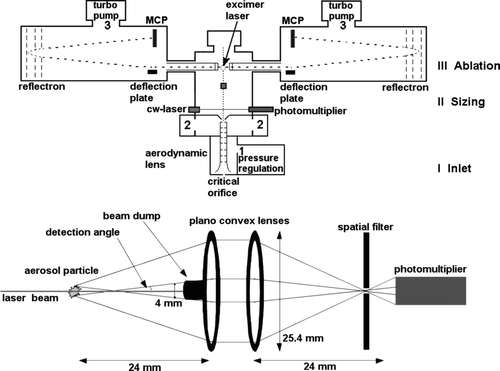
Inlet (I) and Vacuum System
The particles enter the instrument through an aerodynamic lens of the Schreiner or the Liu type and are focused into a narrow beam. The Schreiner lens type was designed by J. Schreiner at the MPI for Nuclear Physics (CitationSchreiner et al. 1999). The lens consists of 7 apertures, which are mounted in a 107 mm long stainless steel tube with an inner diameter of 6.0 mm. The apertures with a thickness of 0.2 mm have decreasing inner diameters from the inlet to the outlet of the lens from 1.3 mm to 0.65 mm and are separated by 13 mm long spacers with inner diameters from 3.5 mm to 2.0 mm. In addition to the 7 apertures, as an accelerating orifice, a 0.25 mm aperture is used at the exit of the aerodynamic lens. A schematic drawing of the lens is presented in the lower part of .
FIG. 2 Comparison of Liu lens (upper part) and Schreiner lens (lower part). Flow direction is from left to right. Upper part reproduced from Aerosol Science & Technology. Transmission Efficiency of an Aerodynamic Focusing Lens System: Comparison of Model Calculations and Laboratory Measurements for the Aerodyne Aerosol Mass Spectrometer (41).721–733. Copyright 2007. Mount Laurel, NJ. Reprinted with permission.
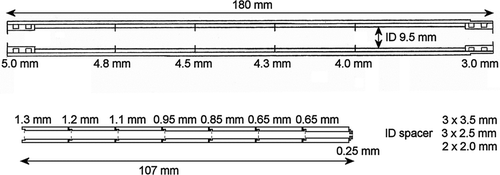
A 250 μ m orifice mounted in front of the lens with a distance of 24 mm is typically used to regulate the flow into the lens. Different volumetric flows can be realized by choosing different critical orifices (100–250 μ m, cf. ). The pressure behind the critical orifice in the pre-vacuum chamber (1) and thus in front of the aerodynamic lens is adjustable. A pressure controller (Bronckhorst, El-Press, P502C-FBB-022A) together with a scroll pump (Varian, SH-100), which also serves as the fore pump for all turbo molecular pumps allows the regulation of the pressure from 50 mbar to 250 mbar at the inlet of the aerodynamic lens. By using this pressure regulation, the instrument is independent of variations in atmospheric pressure which would otherwise lead to changing aerodynamic properties and therefore variations in the flight path and the focusing of the aerosol particles. This independency of the lens performance on pressure variation is a prerequisite for aircraft measurements.
TABLE 1 Different critical orifices used with the Schreiner lens at the SPLAT instrument and resulting flow into the instrument
Alternatively to the above described lens, which focuses particles in the size diameter range of 300 nm to 3000 nm and is not affected by variations in ambient pressure, the aerodynamic lens with the Liu design was also integrated in the SPLAT instrument for the purpose of comparing the detection efficiency. This efficiency is influenced by the cross section of the particle beam and the detection laser beam and hence is a function of particle beam width. The Liu lens focuses particles in the size range from ∼ 80 nm to ∼ 800 nm. The flow rate of 76 cm3/min into the lens is regulated by a 100 μ m critical orifice. The pressure behind the critical orifice at the inlet of the aerodynamic lens is 1.6 mbar at ambient conditions. The lens consists of 6 apertures with decreasing diameters from 5.0 mm to 3.0 mm. The apertures in a 180 mm long stainless steel tube with an inner diameter of 10.3 mm are separated by 29 mm spacers with an inner diameter of 9.5 mm. A schematic drawing of the lens can be found in the upper part of .
In operation, the chamber at the exit of the aerodynamic lens is pumped down to 10−1 mbar by two turbo molecular pumps (Adixen, ATH31+, pump 2 in ). A skimmer with an opening diameter of 1.0 mm separates the first pumping stage from the main vacuum chamber and the two mass spectrometer flight tubes, in which the pressure is reduced down to 10−6 mbar by two turbo molecular pumps (Pfeiffer Vacuum, TMH 261 U-P, pump 3 in ).
Sizing of Particles (II) and Size Calibration
The vacuum aerodynamic diameter of the aerosol particles is determined by the flight time of the particles between two sizing laser beams with a distance of 29 mm. The position of the first detection laser beam is located 47 mm behind the exit of the aerodynamic lens. A green diode pumped solid state Nd:YAG cw-laser (Coherent, compass 315M-150) with a wavelength of 532 nm is coupled into a glass fiber, where the beam is divided into two laser beams by a fiber optic beam splitter (OZ-Optics, Fused-12-532-3.5/125-50/50-3AF1A1A-3-0.5). The laser output power of 150 mW is coupled into the fiber with an efficiency of 70%, so at the end of each fiber optic line a power of 52 mW is available. The ends of the two fiber optic lines are fixed on xy-micro tables (Owis, MKT 40C XY), which allow an accurate adjustment of the detection laser foci with a spatial precision of 1 μ m in both dimensions perpendicular to particle beam propagation. Therefore the distance between the two laser foci remains constant. Each laser beam is focused to a diameter of ∼ 190 μ m (1/e2) by a grin (gradient index) lens, located at the end of the optical fiber, with a focal distance of 85 mm.
The two detection laser beams, separated by a distance of 29 mm, are orientated orthogonal to each other and both orthogonal to the propagation direction of the particle beam. When an aerosol particle crosses the laser focus, the generated scattered light is imaged with two plano convex lenses (Topag, f = 23 mm) onto a photomultiplier (Hamamatsu, R1463). A schematic drawing of the optical detection setup is presented in the lower part of . To minimize the background radiation a spatial filter with an opening diameter of 200 μ m is placed at the focal point of the second lens in front of the multiplier. The scattered light is collected in forward direction under an angle of ∼ 5° to ∼ 24°, whereas the direct laser beam (0° to ∼ 5°) is captured in a beam stop which is a black anodized cup. Further reduction of the background radiation is achieved by using windows with antireflection coatings for λ = 532 nm.
The transit time of the particles between the two foci of the detection laser, which is typically in the order of 150 μ s, is used to obtain the vacuum aerodynamic diameter with a resolution of 50 ns. Only flight times that correspond to reasonable particle sizes are used for further processing. The actual processing rate is 5 Hz. Calibration measurements for the sizing procedure are performed with Polystyrene latex (PSL) particles in the size range from 300 nm up to 3.0 μ m.
Ablation of Particles (III) and Chemical Analysis by TOF-MS
At a distance of 105 mm behind the exit of the aerodynamic lens, an ArF excimer laser (Lambda Physik, Optex) with a wavelength of 193 nm, pulse duration of 8 ns and maximum pulse energy of 13 mJ/pulse evaporates the aerosol particle at least partially and ionizes molecules in the resulting vapor within a single laser pulse. Typically pulse energies of 6–8 mJ/pulse are used in the constant energy mode of the laser. The laser beam is focused with a lens (Linos photonics, f = 272 mm) to a spot size of ∼ 250 μ m × 500 μ m resulting in maximum energy densities of ∼ 1.6· 109 W/cm2. The focus is aligned with the wider dimension parallel to the particle beam.
The ions created by the laser ablation process are extracted by electrodes with Wiley-McLaren type geometry into two time-of-flight mass spectrometers (RM Jordan Inc.). The electrodes have a diameter of 28.5 mm with an opening diameter of 18.5 mm which is covered with a copper grid (transmission 88%) to generate a homogeneous electrical field in the ion source. The distance between the two accelerating grids is 8.5 mm with +/– 1500 V applied to the grids, resulting in an accelerating field of 3530 V/cm.
Both spectrometers are equipped with reflectrons to enhance the mass resolution of the mass spectra. The field free flight path for the ions is 745 mm. A microchannelplate-detector (MCP) with two microchannelplates (25 mm diameter, L/D 40:1) in chevron configuration (Scientific Instruments, S25-10-D) measures a time-depended current due to the varying flight times of ions with different m/z ratios. The cationic MCP signal is terminated with 50 ohm and directly analyzed with a digitizer card, a digital 8 bit oscilloscope-card (Acqiris, DC 240) with two input channels and a maximal sampling rate of 2 GS/s. The anionic MCP signal which is generated at ∼ 4000 V has to be decoupled with a capacitor.
Process Control and Data Acquisition
All turbo molecular pumps, the high voltage supply, pressure regulation at the inlet of the aerodynamic lens, acquisition of housekeeping data and the particle detection system are managed by an embedded controller system (MME Müller Mikroelektronik). Handling of the light scattering signals is performed with a custom-built trigger card. Currently, the maximum data recording rate is 5 Hz which is limited by processing the scattered light signals.
Mass spectra for both polarities are recorded with an 8 bit digitizer card. A 40 μ s time interval is recorded with 2 ns resolution for each polarity which corresponds to a maximum m/z of 424 for cations and 366 for anions. A refinement of mass calibration factors by internal calibration is optional for every spectrum with two or more peaks. The algorithm for refining mass calibration factors is described by CitationHaas and Kalcher (1996). To be accepted as new, the mass calibration factors have to be within 10% and 20% of the old values for slope and intercept, respectively. With this procedure, errors in mass assignment due to excess energy during the ablation process can be minimized, but it is currently not possible to work with accuracy higher than integer masses. The software for data acquisition and data preprocessing is written as Labview program code (National Instruments).
Experimental Setup for Measurements of Detection Efficiency
An aerosol of polystyrene latex (PSL) particles (Duke Scientific) with variable diameters from 300 nm to 3000 nm is generated with a constant output atomizer (TSI, Model 3076) and dried by a diffusion drier filled with silica gel. From 300 nm to 800 nm the aerosol is size-selected with a differential mobility analyzer DMA (TSI, Model 3080). The concentration is measured with a condensation particle counter CPC (TSI, Model 3025A). For PSL particles from 800 nm to 3000 nm there is no size-selection with a DMA and the concentration is measured with an optical particle counter OPC (Grimm, Model 1.108) or an aerodynamic particle sizer APS (TSI, Model 3321). At 800 nm all three methods of calibration can be compared. Typical concentrations for the monodisperse aerosol were 10–20 particles/cm3, which results in detection rates of 0.1–1 Hz, which is below the 5 Hz limit for the detection system.
In this article we define the detection efficiency as the product of the optical detection efficiency, the transmission of the lens and an enrichment factor for the inlet system. The optical detection efficiency is the fraction of the number of particles which are sized compared to the number of particles which enter the sizing region. The transmission of the lens is the fraction of the particles exiting from the lens compared to those which entered the lens. The enrichment factor is only defined for the actively pumped Schreiner lens. Here the particles enter the lens through a critical orifice with 250 μ m diameter which results in a flow rate of 518 cm3/min at ambient pressure. Behind the orifice the pressure is reduced to a value between 50 mbar and 250 mbar by active pressure control. The flow rate through the aerodynamic lens (398 cm3/min) is measured at the lens entrance. If the particles are pumped away with the same ratio as the air, the enrichment factor is 1. The maximum theoretical enrichment factor is 20 (set by the ratio of the ambient pressure and the inlet pressure of the aerodynamic lens) if we assume that all trajectories of the particles which enter the instrument through the critical orifice end in the entrance of the lens and are not influenced by the air trajectories. For the Liu lens the enrichment factor is one because it is not actively pumped. It is not possible to give individual values for the enrichment factor, the transmission of the lens and the optical detection efficiency, but the detection efficiency can be measured and compared with those of other single particle mass spectrometers.
INSTRUMENT CHARACTERIZATION
Particle Size Measurement
For the Liu lens design Knudsen numbers (Kn) are between 1025 and 102.5 for particles in the size range of 80 nm to 800 nm at 1.6 mbar and particle acceleration takes place in the free molecular regime (Kn > 10). Therefore particle sizes are defined as vacuum aerodynamic diameters (d va ) and calculations have to be performed according to CitationDeCarlo et al. (2004). For the Schreiner lens design (particles with diameters between 300 nm and 3000 nm at 50 mbar to 250 mbar) Kn values are between 8.7 and 0.87, so particle acceleration takes place in the transition regime (0.1 < Kn < 10). However, calculations for the Schreiner lens design are also performed with the vacuum aerodynamic diameter to have better comparability. The maximum error is the square root of the density, which is 1.025 for PSL particles (density 1.05 g/cm3).
The SPLAT instrument determines the vacuum aerodynamic diameter of a particle by measuring the transit time between the foci of the two detection lasers. To calculate the diameter from the flight time, various calibration measurements with standard materials have to be carried out. The flight time is fitted with a quadratic function to the vacuum aerodynamic diameter. A size distribution of PSL particles with 10 different diameters ranging from 0.4 μ m to 3.0 μ m at a pressure of 90 mbar at the entrance of the aerodynamic lens (Schreiner type) is shown in . The different sizes are clearly separated. The vacuum aerodynamic diameters for the PSL particles calculated from the quadratic fit are listed in . The standard deviations from Gaussian fits to the size distributions are given as uncertainties.
FIG. 3 Particle histogram for PSL particles of different sizes focused with the Schreiner lens. The insert shows a Gaussian fit to the distribution for the 800 nm particles. The FWHM is 8nm.
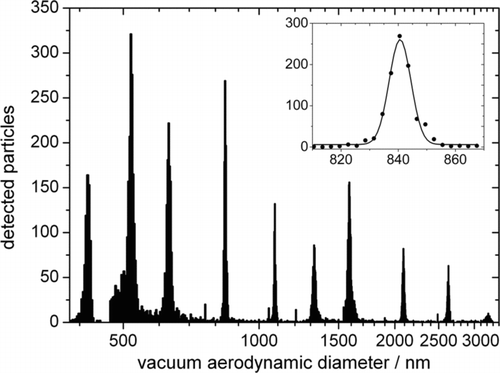
TABLE 2 Geometric diameter of PSL particles according to the manufacturer and calculated vacuum aerodynamic diameter. Also the vacuum aerodynamic diameter determined with the Schreiner and the Liu lens designs are shown. As errors the width of the Gaussian fit to the size distribution are given
shows a size distribution for various PSL particles in the size range from 300 nm to 800 nm, focused with the Liu lens. Although the Liu lens has a high transmission for particles in the size range between 80 nm and 800 nm (CitationLiu et al. 2007), calibrations with particles smaller than 300 nm are not possible because in our setup the light scattering detection becomes too inefficient. The vacuum aerodynamic diameters calculated from the calibration for the Liu lens design are presented together with the standard deviations in . Similar to the Schreiner lens setup the Liu lens setup provides clearly separated size distributions for the different particles sizes. The uncertainties derived from the Gaussian fit of the different size modes are similar to those from the Schreiner lens setup and both are close to the manufacturer's specifications. If it is assumed that the largest instrumental source of uncertainty is the duration of the light scattering pulse compared to the flight time between the two detection lasers, a relative error of the size measurement of 0.66% can be calculated which is not size dependent. This value is smaller compared to the relative error of the width of the measured size distributions calculated from , found to be between 2.1% and 0.7% for both aerodynamic lenses. Therefore the uncertainty of the size measurements with the SPLAT instrument is determined by the uncertainty of the PSL particle sizes.
Because particle acceleration in the last aperture of the lens and therefore the transit time through the detection laser setup is dependent on the pressure in the aerodynamic lens, particle size calibrations have been carried out for pressures in the range of 50 mbar to 250 mbar to cover the whole adjustable pressure range of the Schreiner lens. shows the relationship between particle time-of-flight and particle vacuum aerodynamic diameter for seven different pressures at the inlet of the Schreiner lens. For each pressure there is a satisfactory quadratic dependence between particle time-of-flight and particle vacuum aerodynamic diameter. With increasing pressure at the inlet of the Schreiner lens the difference to the pressure at the exit of the lens becomes larger and therefore particles are accelerated to higher velocities in the last aperture of the lens, thus particle flight times between the two detection lasers decrease.
FIG. 5 Relationship between the time-of-flight of particles and their vacuum aerodynamic diameter, measured at different pressures in front of the aerodynamic lens (Schreiner type).
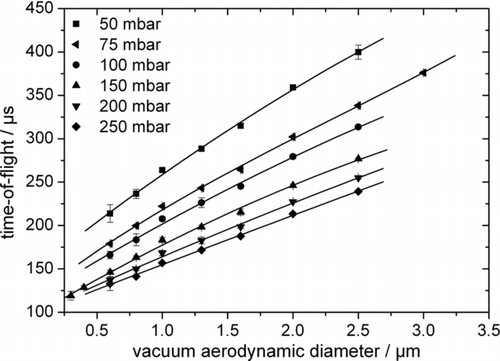
Similar measurements for the Liu lens were already presented in the literature (CitationSchneider et al. 2006). There the velocities for particles with a diameter of 40 nm to 1000 nm were determined for a pressure range from 1000 mbar to 200 mbar, which corresponds to lens pressures of 1.6 mbar to 0.56 mbar. Particle velocities are in the range of 200 m/s for 40 nm particles at 1000 mbar ambient pressure to 40 m/s for 1000 nm particles at 200 mbar.
Particle velocities measured in different aerosol mass spectrometers with different inlets (Schreiner, Liu lens and capillaries) are shown in . Due to the low pressure difference between the inlet and exit of the Liu lens (deployed in the Aerodyne Aerosol Mass Spectrometer and the SPLAT-MS by Imre and co-workers) particles reach velocities up to 150 m/s only. The Schreiner lens (deployed in our SPLAT and PALMS) works with a higher pressure difference, which is also variable. Therefore particles are accelerated to higher velocities compared to the Liu design. The highest velocities, up to 420 m/s are achieved with a capillary inlet (deployed in old versions of ATOFMS and SPLAT and also LAMPAS 2).
FIG. 6 Particle velocities for different aerosol mass spectrometers. Particles focused with the Liu lens are the slowest with velocities up to 150 m/s. With the Schreiner lens particles become faster, 200 m/s up to 300 m/s depending on the inlet pressure of the lens. Capillary inlet systems provide the highest particle velocities up to 420 m/s. The error bars for our SPLAT instrument are dominated by the uncertainty in the distance between the two detection laser beams, which is set to be ±2 mm.

The different particle velocities have to be taken into account when discussing effects like evaporation of volatile components due to long residence times in a high vacuum environment. In addition to this, the choice of the ionization laser and the necessary trigger scheme can be affected by the particle velocity when designing a new single particle laser ablation instrument. Both effects are discussed in detail by CitationHinz and Spengler (2007).
Detection Efficiency
A disadvantage of the aerodynamic lens design by J. Schreiner is the variation of the particle beam diameter with lens pressure and particle size. shows the pressure dependence of the particle beam width for 800 nm particles. These particles are focused to a beam diameter (standard deviation of Gaussian fit) of 0.14 mm at 250 mbar at the position of the second photomultiplier, which is located 76 mm behind the exit of the aerodynamic lens. With these values a solid angle of 1.07 · 10−5 sr can be calculated, which is comparable with the value of 4.4 · 10−6 sr presented by CitationHuffman et al. (2005) for the Schreiner lens in a summary of particle beam width measurements. At lower pressures the beam becomes broader (0.35 mm at 200 mbar and 0.49 mm at 150 mbar) and as a consequence the detection efficiency decreases.
FIG. 7 Beam width measurements for 800 nm PSL particles at different pressures in the Schreiner lens measured at the position of the second detection laser beam. Error bars show the standard deviation of several measurements.
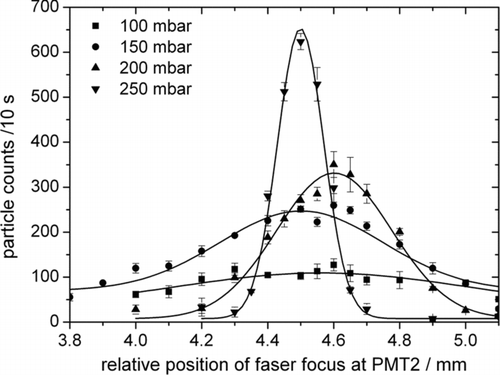
With the Schreiner lens, optimum focusing properties for different particle sizes are achieved at different pressures. This can clearly be seen in where detection efficiencies for different particle sizes at various pressures are shown. When increasing the particle size from 300 nm to 800 nm the maximum detection efficiency is shifted to higher pressures. This can be explained by the differences in the particle stopping distance. Larger particles need higher pressures in the aerodynamic lens to influence their trajectories in such a way that they do not impact on the apertures. For larger particles no distinct detection efficiency maximum can be found within the pressure range of the measurement.
FIG. 8 Detection efficiency for the SPLAT equipped with the Schreiner lens. Efficiencies were determined for 9 different sizes (from 300 nm to 2000 nm) at 14 different pressures. The 300 nm detection efficiencies are multiplied by 50 for better visibility.
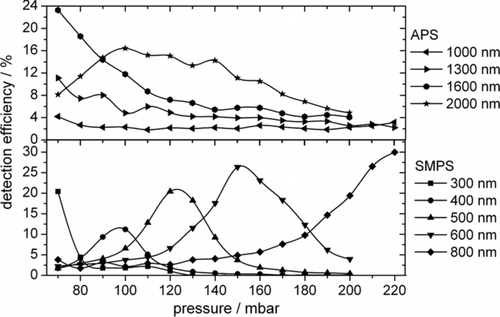
shows a comparative measurement for 800 nm particles with three reference techniques. All three measurements agree within the uncertainty of measurement, which is shown exemplarily for the APS measurement at 190 mbar. There the absolute error of the detection efficiency is ± 2.5% with the largest fraction emerging from the 10% relative error for the particle concentration measured with the APS instrument. In it was shown that 800 nm particles are focused best at 250 mbar. This result is in agreement with the data from , where at 220 mbar the detection efficiency for 800 nm particles is still increasing.
FIG. 9 Detection efficiency for 800 nm particles focused with the Schreiner lens, measured with three different reference techniques (SMPS, APS, OPC).
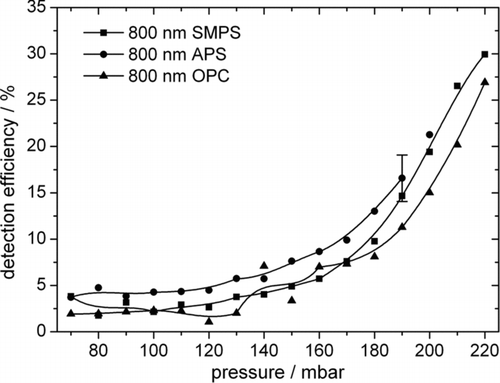
In the PhD thesis by P. CitationBudz (2002) from J. Schreiner's group at the MPI Heidelberg a lens with exactly the same aperture layout as ours has been characterized. At 87 mm from the exit of the aerodynamic lens a beam width of 0.5–2.5 mm for particle sizes between 0.3 μ m and 5.0 μ m at pressures from 100 mbar to 200 mbar was found. The resulting solid angle is 1.04 · 10−4 sr to 2.60 · 10−3 sr. For defining the beam width they used the “two standard deviation” definition. The beam width values are close to those found in , where the beam width is between 0.14 mm and 0.49 mm. With a width of the detection laser focus of ∼ 190 μ m, it can easily be seen that the detection efficiency can not exceed 35% due to the fact that there is a limited overlap between the detection laser beam and the particle beam generated by the aerodynamic lens. Other reasons reducing the detection efficiency are the transmission efficiency of the aerodynamic lens and other transmission losses of the inlet system.
Similar measurements of the detection efficiency were performed using the Liu aerodynamic lens as an inlet for our SPLAT instrument. shows the detection efficiency measured for different particle sizes from 300 nm to 2000 nm. For 500 nm and 600 nm particles the maximum detection efficiencies are > 50%. This is a factor of 1.6 larger maximum detection efficiency compared to the Schreiner lens setup for 800 nm particles at 250 mbar. A similar factor between the two inlet configurations was found when ambient air was sampled over a period of 4 h and the mean detection efficiency over the whole size range was calculated. With the Schreiner lens setup at 90 mbar a mean detection efficiency of 2.0% was achieved, while with the Liu lens setup this value increased to 7.3%.
FIG. 10 Detection efficiency for SPLAT equipped with the Liu lens. Concentrations of particles with sizes up to 800 nm were measured with a SMPS system. Starting with 800 nm an APS system was used. The error bars are dominated by the uncertainty of the measurement of the reference concentration (10% relative error for SMPS and APS).
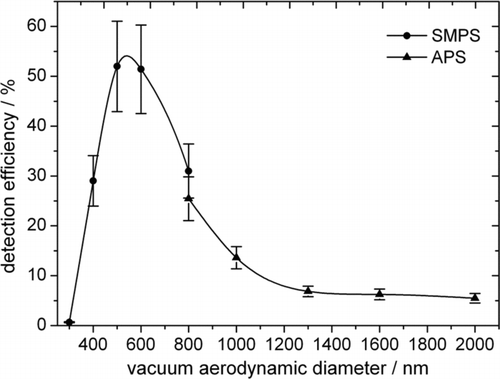
The shape of the detection efficiency profile for the Liu lens in is caused by two limitations. For particle sizes smaller than 300 nm the scattered light intensity is so small that it can not be distinguished from the background radiation in our optical detection setup. Therefore the detection efficiency decreases for particles smaller than 400 nm, although the Liu lens has a transmission of close to 100% for this particle size (CitationLiu et al. 2007). Variations in particle beam width are unlikely to be responsible for the strong decrease in detection efficiency for small particles because only factors of up to 5 for solid angles for different particles sizes focused with the Liu lens can be found in the study by CitationHuffman et al. (2005). For large particles the detection efficiency decreases because the Liu lens has only a very low transmission for particles larger than 800 nm (CitationLiu et al. 2007). These two limitations account for the fact that the working range of the SPLAT instrument and the Liu lens do not match perfectly. Nevertheless the mean detection efficiency for the Liu lens setup is still higher than for the Schreiner lens setup.
As a consequence, in future field applications the Schreiner lens will be used in our SPLAT instrument which is able to detect particles with diameters larger than 300 nm, if one is preferentially interested in the chemical composition of particles larger than 1000 nm. For these supermicron particles the detection efficiency of our instrument with the Schreiner lens is larger compared to the Liu lens setup. For the submicron particles down to 300 nm the Liu lens is favored especially at low particle concentrations because in this size region the Liu lens setup is more efficient. At the moment the pressure controlled Schreiner lens design is favored for aircraft based measurements because the measurements are not influenced by variations in ambient pressure. But work on the implementation of a pressure control for the Liu lens and characterization of the transmission has begun in our group.
Ablation of Single Particles
The ablation laser evaporates and ionizes the particles at a point 105 mm behind the exit of the aerodynamic lens and 29 mm behind the second detection laser beam. Beam propagation of the ablation laser beam is parallel to the second detection laser beam. Alignment of the ablation laser is achieved by horizontal movement of the laser beam perpendicular to the particle beam and variation of the laser trigger timing which corresponds to a movement in direction of particle beam propagation as described above. shows the result of a screening of the cross section between particle beam and ablation laser beam. Ablation of particles producing a mass spectrum with one or more signals larger than 10% of the maximum signal intensity are counted as hit particles. Maximum hit rates (ratio of hit particles to sized particles) of 94% can be obtained, which results in a maximum overall efficiency (product of detection efficiency and hit rate) of ∼ 30% for 800 nm particles at 250 mbar with the Schreiner lens setup. From the screening plot in the size of the ionizing laser focus can be derived as 300 μ m × 550 μ m. These dimensions are in good agreement with the focus dimensions on photographic paper which can be seen on the right side of .
FIG. 11 Hit rate of detected particles as a function of ablation laser focus position. By moving the excimer laser beam in the horizontal position and shifting the laser pulse in the time domain, which corresponds to a vertical movement, the cross section of the particle beam is screened. Hit rates above 80% can be achieved in the center region. On the right side a burn pattern from the laser focus on photographic paper is shown.
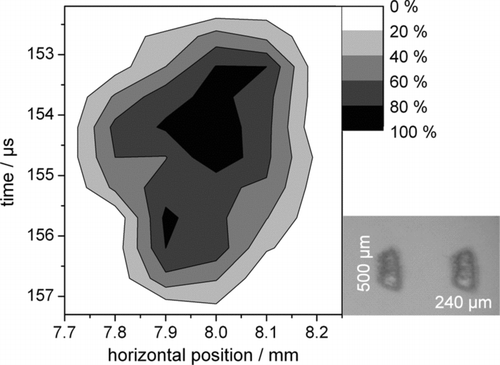
This efficiency is valid only for one particle size at one inlet pressure. To be able to compare the overall efficiency with those of other instruments, measurements with ambient aerosol concentrations were performed. Ambient air was sampled over a period of four hours. The number of hit particles was compared to the ambient particle concentration determined with an OPC. The measurements showed overall efficiencies of 1.9% with the Schreiner lens setup. Hit rates for the Liu lens setup do not differ from the Schreiner lens setup. With a hit rate of 94% the overall efficiency calculated from the mean detection efficiency for the Liu lens setup is 6.9%. shows detection efficiencies and hit rates of different single particle laser ablation instruments with different inlets (Schreiner, Liu lens and capillary) from our measurements and from the literature.
TABLE 3 Detection efficiencies, hit rates and size ranges of different single particle laser ablation instruments. All instruments except the LAMPAS 2 work with an aerodynamic lens. LAMPAS 2 uses a capillary inlet
Characterization of the Mass Spectrometer
The mass spectrometer used in the SPLAT instrument is a bipolar time-of-flight mass spectrometer equipped with reflectrons. The mass resolution for both polarities is 230 at m/z 36. The resolution is sufficient to separate integer masses over a broad mass range. The mass accuracy is ± 0.20 at m/z 36 and ± 0.33 at m/z 50. With these values it is possible to work with one mass calibration up to m/z 100, which is often sufficient due to intense fragmentation in our mass spectra. If spectra with m/z values beyond 100 are evaluated a mass calibration has to be carried out for every single particle spectrum. Different starting energies of the ions due to excess energy during the ablation process are the main reason for variations in the mass accuracy.
CONCLUSION
In this article we describe the setup and characterization of our Single Particle Laser Ablation Time-of-flight mass spectrometer (SPLAT) equipped with two different aerodynamic lenses. Using the Schreiner lens we achieve a mean detection efficiency of 2.0% in the size range of 300 nm to 3000 nm. The lens is actively pumped and therefore well suited for airborne measurements. The pressure at the inlet can be regulated between 50 mbar and 250 mbar. The beam width of the focused particle beam and thus the detection efficiency of our SPLAT instrument are strongly dependent of the particle size and the pressure at the inlet of the aerodynamic lens.
The mean detection efficiency of our instrument when equipped with the Liu lens is 7.3% in the size range of 300 nm to 2000 nm. The higher detection efficiency shows that the beam width of the Liu lens is smaller compared to the Schreiner lens. However, the operating regime of the Liu lens and our instrument do not match perfectly. The Liu lens focuses particles best in the size range between 80 nm and 800 nm but our instrument currently detects only particles that are larger than 300 nm.
The mass spectrometer of our SPLAT instrument shows a resolution high enough to separate single masses up to the size region of m/z 200, enabling us to investigate the chemical composition of individual aerosol particles.
Acknowledgments
Wethank Jochen Schreiner from the Max Planck Institute of Nuclear Physics in Heidelberg, Germany, for the development of the aerodynamic lens which was implemented in our aerosol mass spectrometer and Thomas Böttger for supporting the development of the SPLAT instrument. Financial support of the German Science Foundation DFG within the Collaborative Research Center 641 “The Tropospheric Ice Phase” and the Research Training Group 826 “Trace Analysis of Elemental Species” as well as internal funding by Max Planck Institute for Chemistry is gratefully acknowledged. M. Brands wants to thank the federal state of Rheinland Pfalz for funding within the Excellence Cluster “Geocycles.”
Notes
* Now at: Institute for Atmospheric and Environmental Sciences, Johann Wolfgang Goethe-University, Frankfurt, Germany
REFERENCES
- Bahreini , R. , Jimenez , J. L. , Wang , J. , Flagan , R. C. , Seinfeld , J. H. , Jayne , J. T. and Worsnop , D. R. 2003 . Aircraft-Based Aerosol Size and Composition Measurements During ACE-Asia Using an Aerodyne Aerosol Mass Spectrometer . J. Geophys. Res. , 108 (D23):8645, doi: 10.1029/2002JD003226
- Budz , P. 2002 . Bildung Und Untersuchung Stratosphärisch Relevanter Fester Phasen in Der AIDA Aerosolkammer , PhD work University of Heidelberg .
- Canagaratna , M. R. , Jayne , J. T. , Jimenez , J. L. , Allan , J. D. , Alfarra , M. R. , Zhang , Q. , Onasch , T. B. , Drewnick , F. , Coe , H. , Middlebrook , A. , Delia , A. , Williams , L. R. , Trimborn , A. M. , Northway , M. J. , DeCarlo , P. F. , Kolb , C. E. , Davidovits , P. and Worsnop , D. R. 2007 . Chemical and Microphysical Characterization of Ambient Aerosols with The Aerodyne Aerosol Mass Spectrometer . Mass Spec. Rev. , 26 : 185 – 222 .
- Cziczo , D. J. , DeMott , P. J. , Brock , C. , Hudson , P. K. , Jesse , B. , Kreidenweiss , S. M. , Prenni , A. J. , Schreiner , J. , Thomson , D. S. and Murphy , D. M. 2003 . A Method for Single Particle Mass Spectrometry of Ice Nuclei . Aerosol Sci. Technol. , 37 : 460 – 470 .
- Cziczo , D. J. , Murphy , D. M. , Hudson , P. K. and Thomson , D. S. 2004 . Single Particle Measurement of the Chemical Composition of Cirrus Ice Residue During CRYSTAL-FACE . J. Geophys. Res. , 109 (D04201), doi: 10.1029/2003JD004032
- Cziczo , D. J. , Thomson , D. S. , Thompson , T. L. , DeMott , P. J. and Murphy , D. M. 2006 . Particle Analysis by Laser Mass Spectrometry (PALMS) Studies of Ice Nuclei and Other Low Number Density Particles . Int. J. Mass Spec. , 258 : 21 – 29 .
- DeCarlo , P. F. , Slowik , J. G. , Worsnop , D. R. , Davidovits , P. and Jimenez , J. L. 2004 . Particle Morphology and Density Characterization by Combined Mobility and Aerodynamic Diameter Measurements. Part 1: Theory . Aersol Sci. Technol. , 38 : 1185 – 1205 . doi: 10.1080/027868290903907
- DeCarlo , P. F. , Kimmel , J. R. , Trimborn , A. , Northway , M. J. , Jayne , J. T. , Aiken , A. C. , Gonin , M. , Fuhrer , K. , Horvath , T. , Docherty , K. S. , Worsnop , D. R. and Jimenez , J. L. 2006 . Field-Deployable, High-Resolution, Time-of-Flight Aerosol Mass Spectrometer . Anal. Chem. , 78 : 8281 – 8289 .
- Gard , E. , Mayer , J. E. , Morrical , B. D. , Dienes , T. , Fergenson , D. P. and Prather , K. A. 1997 . Real-Time Analysis of Individual Atmospheric Aerosol Particles: Design and Performance of a Portable ATOFMS . Anal. Chem. , 69 : 4083 – 4091 .
- Haas , G. J. R. and Kalcher , K. 1996 . Fast Recording Software with Automatic Mass Calibration for the Laser-Microprobe-Mass-Analyzer LAMMA-500 . Computers Chem. , 20 : 347 – 352 .
- Hinz , K.-P. , Trimborn , A. , Weingartner , E. , Henning , S. , Baltensberger , U. and Spengler , B. 2005 . Aerosol Single Particle Composition at the Jungfraujoch . J. Aerosol Sci. , 36 : 123 – 145 .
- Hinz , K.-P. and Spengler , B. 2007 . Instrumentation, Data Evaluation and Quantification in on-Line Aerosol Mass Spectrometry . J. Mass Spec. , 42 : 843 – 860 .
- Huffman , J. A. , Jayne , J. T. , Drewnick , F. , Aiken , A. C. , Onasch , T. , Worsnop , D. R. and Jimenez , J. L. 2005 . Design, Modelling, Optimization, and Experimental Tests of a Particle Beam Width Probe for the Aerodyne Aerosol Mass Spectrometer . Aerosol Sci. Technol. , 39 : 1143 – 1163 . doi: 10.1080/02786820500423782
- Kleimann , L. I. , Daum , P. H. , Lee , Y.-N. , Senum , G. I. , Springston , S. R. , Wang , J. , Berkowitz , C. , Hubbe , J. , Zaveri , R. A. , Brechtel , F. J. , Jayne , J. , Onasch , T. B. and Worsnop , D. 2007 . Aircraft Observations of Aerosol Composition and Ageing in New England and Mid-Atlantic States During the Summer 2002 New England Air Quality Study Field Campaign . J. Geophys. Res. , 112 (D09310), doi: 10.1029/2006JD007786
- Liu , P. S. K. , Deng , R. , Smith , K. A. , Williams , L. R. , Jayne , J. T. , Canagaratna , M. R. , Moore , K. , Onasch , T. B. , Worsnop , D. R. and Deshler , T. 2007 . Transmission Efficiency of an Aerodynamic Focusing Lens System: Comparison of Model Calculations and Laboratory Measurements for the Aerodyne Aerosol Mass Spectrometer . Aerosol Sci. Technol. , 41 : 721 – 733 . doi: 10.1080/02786820701422278
- Liu , P. , Ziemann , P. J. , Kittelson , D. B. and McMurry , P. H. 1995a . Generating Particle Beams of Controlled Dimensions and Divergence: I. Theory of Particle Motion in Aerodynamic Lenses and Nozzle Expansions . Aerosol Sci. Technol. , 22 : 293 – 313 .
- Liu , P. , Ziemann , P. J. , Kittelson , D. B. and McMurry , P. H. 1995b . Generating Particle Beams of Controlled Dimensions and Divergence: II. Experimental Evaluation of Particle Motion in Aerodynamic Lenses and Nozzle Expansions . Aerosol Sci. Technol. , 22 : 314 – 324 .
- Mallina , R. V. , Wexler , A. S. , Rhoads , K. P. and Johnston , M. V. 2000 . High Speed Particle Beam Generation: A Dynamic Focusing Mechanism for Selecting Ultrafine particles . Aerosol Sci. Technol. , 33 : 87 – 104 .
- Murphy , D. M. 2007 . The Design of Single Particle Laser Mass Spectrometers . Mass Spec. Rev. , 26 : 150 – 165 .
- Nash , D. G. , Baer , T. and Johnston , M. V. 2006 . Aerosol Mass Spectrometry: An Introductory Review . Int. J. Mass Spec. , 258 : 2 – 12 .
- Petrucci , G. A. , Farnsworth , P. B. , Cavalli , P. and Omenetto , N. 2000 . A Differentially Pumped Particle Inlet for Sampling of Atmospheric Aerosols into a Time-of-Flight Mass Spectrometer: Optical Characterization of the Particle Beam . Aerosol Sci. Technol. , 33 : 105 – 121 .
- Prather , K. A. , Nordmeyer , T. and Salt , K. 1994 . Real-Time Characterization of Individual Aerosol Particles Using Time-of-Flight Mass Spectrometry . Anal. Chem. , 66 : 1403 – 1407 .
- Schneider , J. , Borrmann , S. , Wollny , A. G. , Bläsner , M. , Mihalopoulos , N. , Oikonomou , K. , Sciare , J. , Teller , A. , Levin , Z. and Worsnop , D. R. 2004 . Online Mass Spectrometric Aerosol Measurements During the MINOS campaign (Crete, August 2001) . Atmos. Chem. Phys. , 4 : 65 – 80 .
- Schneider , J. , Hings , S. S. , Hock , B. N. , Weimer , S. , Borrmann , S. , Fiebig , M. , Petzold , A. , Busen , R. and Karcher , B. 2006 . Aircraft-Based Operation of an Aerosol Mass Spectrometer: Measurements of Tropospheric Aerosol Composition . J. Aerosol Sci. , 37 : 839 – 857 .
- Schreiner , J. , Schild , U. , Voigt , C. and Mauersberger , K. 1999 . Focussing of Aerosols into a Particle Beam at Pressures from 10 to 150 torr . Aerosol Sci. Technol. , 31 : 373 – 382 .
- Su , Y. , Sipin , M. F. , Furutani , H. and Prather , K. A. 2004 . Development and Characterization of an Aerosol Time-of-Flight Mass Spectrometer With Increased Detection Efficiency . Anal. Chem. , 76 : 712 – 719 .
- Thomson , D. S. , Schein , M. E. and Murphy , D. M. 2000 . Particle Analysis by Laser Mass Spectrometry WB-57F Instrument Overview . Aerosol Sci. Technol. , 33 : 153 – 169 .
- Trimborn , A. , Hinz , K.-P. and Spengler , B. 2000 . Online Analysis of Atmospheric Particles with a Transportable Laser Mass Spectrometer . Aerosol Sci. Technol. , 33 : 191 – 201 .
- Wollny , A. G. 2002 . Entwicklung Eines Bipolaren Flugzeitmassenspektrometers zur Analyse der chemischen Zusammensetzung von individuellen Aerosolpartikeln , PhD work University of Bonn .
- Zelenyuk , A. and Imre , D. 2005 . Single Particle Laser Ablation Time-of-flight Mass Spectrometer: An introduction to SPLAT . Aerosol Sci. Technol. , 39 : 554 – 568 .
